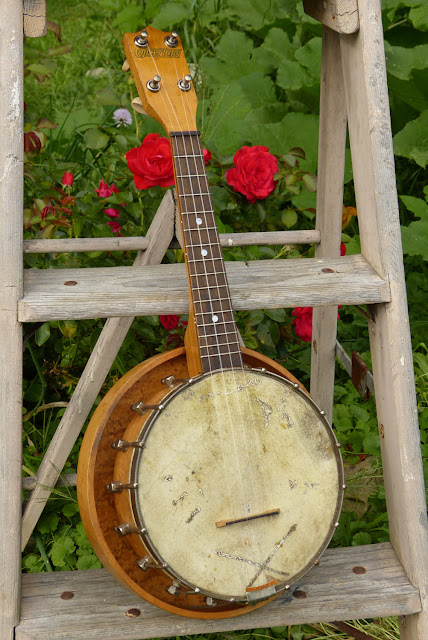1920s Concertone 8" Resonator Banjo Ukulele
I'm still not exactly certain who made this style of banjo uke. It comes in a variety of brands and is fairly common -- mostly affiliated with the Slingerland company out of Chicago -- and I'm pretty sure they were made by Regal. This one is nicer than average, with a larger 8" rim, 10" resonator on the back, and a long, 14" scale length. The neck is quick and slim like a mandolin neck and I believe it was intended, when first made, to be strung with steel as the original nut and bridge were definitely slotted too thin for standard gut ukulele strings of the time. This isn't that surprising, however, as many steel-string banjo uke sets were available at the time and crusty old 1920s steel strings constantly appear on period jo-ukes.
Despite the obvious use-related wear and tear, this is still a grand little uke. It's all-original save the tuners (which are cobbled 1920s units), strings, and three hook/nuts (which are also 1920s units). My work on it included a fret level/dress, a tiny patch to a pinhole on the head (nothing serious), swapping-out the tuners for the friction pegs currently on it, a bolt for the neck attachment rather than a shim, and a good setup. It's strung with fluorocarbon strings and plays on-the-dot at 1/16" action overall at the 12th fret.
Its voice is direct, loud, and snappy -- but with good depth. This lacks a tonering which keeps it "plainspoken" and non-shrieky. It's thus ideal for that vaudeville uke style or Formby chitter-chatter.
The marks on the head appear to be white-out or paint. Who knows? It looks cool.
The rim is multi-ply maple and the rim and resonator both have birdseye-maple veneer on their outsides.
The neck is maple, the fretboard is stained maple, and the nut is ebony. This has a 1 1/8" nut width and a soft-V neck profile on the rear.
The face dots are pearl and I added side dots. The original frets have good life left in them and are nickel-silver.
The pad of leather is to cut down on string-afterlength overtones.
The friction pegs have ivoroid buttons.
Here's inside the rim.
Note how I've changed the neck-brace area -- it now has a single, big, bolt that tightens-up the neck to the pot. This is simple and effective. The wood shim used to go in that slot in the dowel and secure it via knocked-in friction. They always loosen-up just at the wrong moment.
The pad of fabric behind the dowel just damps the head slightly to remove extra overtones.



















Comments